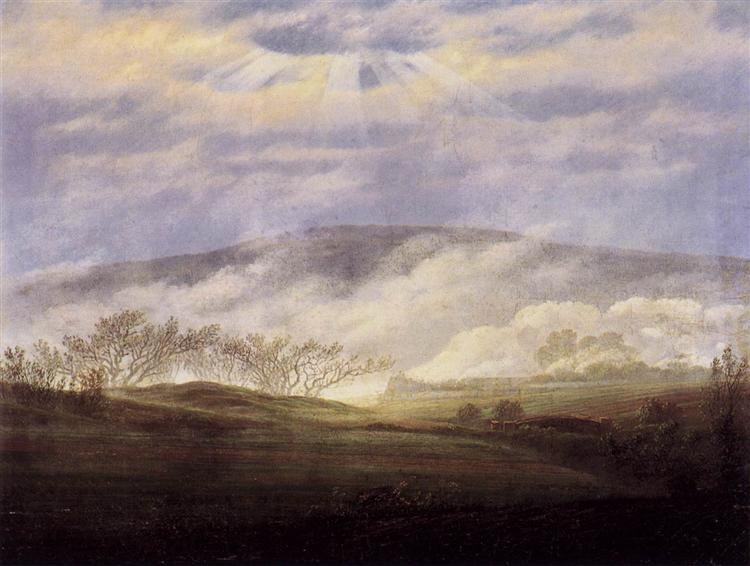Opis
Caspar David Friedrich's Fog in the Elbe Valley, created in 1821, is a splendid example of German Romanticism and the way this artistic movement explored the individual's relationship with nature. Friedrich is known for his ability to evoke a profound sense of the sublime through landscapes that often capture meditative and emotional moments, and this painting is no exception. Upon observing the scene, one is immediately captivated by the hazy atmosphere that envelops the Elbe Valley, as if the fog becomes a veil that both conceals and reveals.
The composition of the work is meticulously constructed to guide the viewer’s gaze through a series of layers of depth. In the foreground, the space is dominated by the thick fog that hangs over the valley, creating a sense of mystery and remoteness. The gentle undulations of the landscape suggest the presence of hills and forests, although these elements are almost ghosts that fade into the mist. The painter achieves a balance between the visible and the hidden, inviting a meditation on the unknown. This effect is characteristic of Romanticism, which often seeks to excite through nature in its most elusive and mysterious form.
Colour also plays a key role in creating atmosphere. Friedrich employs a mostly neutral palette, with shades of grey and green suggesting serenity but also a slight unease. Light seems to filter through the mist, creating a soft glow that reflects off the darker parts of the landscape, adding an almost spiritual dimension to the work. This technique of light and shadow has been one of Friedrich’s signature features, as he often draws inspiration from the landscape of his native Pomerania to construct settings that are both real and metaphysical.
Interestingly, there are no obvious human characters in this painting, which is a deliberate choice on the part of the artist. Instead, the absence of human figures can be interpreted as a comment on the insignificance of man in the face of the vastness of nature. In many of Friedrich’s works, the characters are often present at the edge of an abyss or a visible horizon, lost in thought, symbolizing the internal conflict between human desire and the natural environment. This decision to leave the viewer in the company of the mist in this work suggests a deep connection with the landscape, an invitation to introspection without distractions.
When considering the broader significance of Romanticism in the context of Friedrich's work, it is unavoidable to mention its influence on later artistic movements, as well as its role in the development of landscape painting in Europe. His approach to nature is not merely representational, but seeks to capture the emotional state of the viewer when contemplating the overwhelming beauty of the natural world. "Fog in the Elbe Valley" acts as a bridge between pure observation and personal experience, establishing a dialogue that resonates with the viewer even years after its creation.
In sum, “Fog in the Elbe Valley” is a work that not only encapsulates Caspar David Friedrich’s technical mastery, but also represents a profound meditation on the solitude and grandeur of the landscape. Fog serves as a symbol of the unknown and the ethereal, leaving the viewer in a state of reflection that is as pertinent today as it was in the context of German Romanticism. Through this work, Friedrich did not just paint a landscape, but also captured a mood that resonates with humanity’s eternal quest to understand its place in the vast mural of existence.
KUADROS ©, a famous painting on your wall.
Hand-made oil painting reproductions, with the quality of professional artists and the distinctive seal of KUADROS ©.
Painting reproduction service with satisfaction guarantee. If you are not completely satisfied with the replica of your painting, we will refund 100% of your money.

